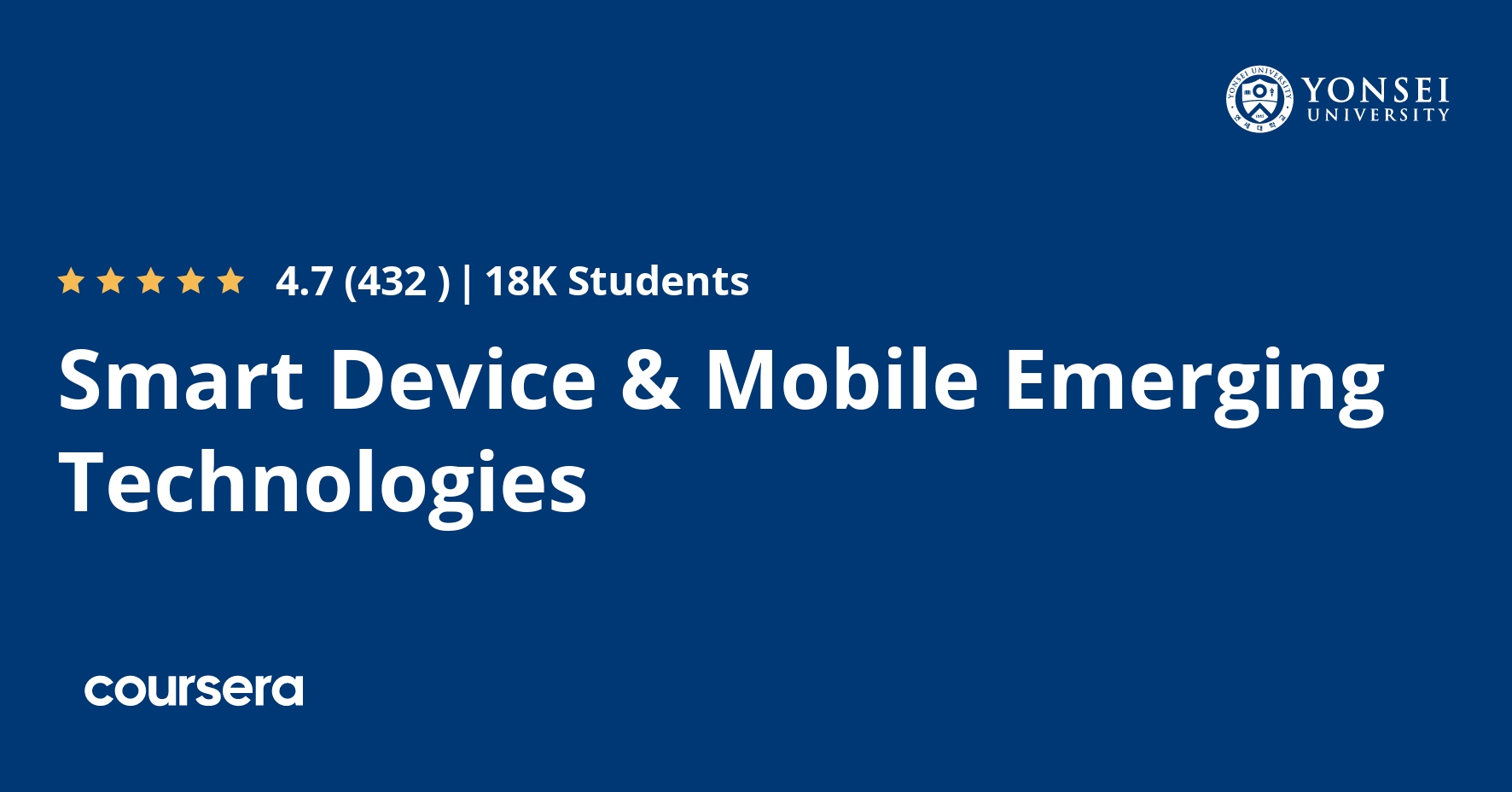Description
Every day you use your smartphone. Your smartphone wakes you up, it is the first thing you use in the morning, and the last thing you check (e.g., alarm setting) before you sleep. In addition, you use it all day. A typical cellphone user touches their mobile phone 2,617 times a day (Dscout report based on 2017) and people spend over 4 hours a day on their mobile phones (Hackernoon report) on average. Smartphones and smart watches are very useful and will become even more useful due to their smaller sizes, lighter weights, versatile functionalities, advanced mobile communications & wireless networking (e.g., Wi-Fi & Bluetooth) technologies. In this course, the start-of-the-art smartphone and smart watch technology and components in addition to the global market trends and future forecasts are introduced. Since everybody uses smartphones and smart watches, knowing the details about the most globally used electronic device will definitely help you in all aspects of new product and app design & development, as well as business planning. In addition, the core technology and components of the world’s most popular smartphones (i.e., the Samsung Galaxy Note8 and Apple iPhone X) and smart watches (i.e., Samsung Gear S3 and the Apple Watch Series 3) are introduced along with details of the iOS and Android smartphone OSs (Operating Systems) and mobile communications 1G to 5G (for details on Wi-Fi and Bluetooth, please take my course “IoT Wireless & Cloud Emerging Technology”). This course ends with projects that teach how to analyze the components of smartphones and check the mobile network. Consequently, this course will prepare you to be more successful in businesses strategic planning in the upcoming smart device era. I cordially welcome you in to the amazing internal dynamics of the smart device world!
What you will learn
Mobile Business Rankings & Analysis
The first module “Smart Device & Mobile Services Rankings & Products” focuses on the future trend of smart devices and mobile services based on rankings and products, which is followed by three important forecasts. First, a forecast of the global telecom terminal market (based on mobile devices, base stations, and telecom services are provided) is provided. Second, a forecast of the global wearable device market (based on smart watches, smart glasses, fitness bands and other wearable devices) is provided. Third, a forecast of the global mobile network equipment market (based on base-stations, small cells, core network, and the combined total value) is provided. In order to explain the forecast evaluation scale, the definition of CAGR (Compound Annual Growth Rate) is introduced in the market analysis. Next, a market analysis of the global market share based on market share by country (e.g., USA, China, India, UK, and Brazil), smartphone venders (e.g., Samsung, Apple, Huawei, and OPPO), and global mobile subscription technology (e.g., LTE, GSM, HSPA, CDMA, and TD-SCMA) are explained. This is followed by a forecast of the global mobile application market based on APP (Application) download, in-APP payment, and in-APP advertisements. Through the lectures of this module, the current status and future trends of the mobile smart device world are fully revealed.
Smart Devices
The second module “Smart Devices” focuses on the core technology and components of the world’s most popular smartphones (i.e., the Samsung Galaxy Note8 and and Apple iPhone X) and smart watches (i.e., Samsung Gear S3 and the Apple Watch Series 3). The state-of-the-art smartphones’ camera, battery, CPUs, GPUs, chipsets (e.g., Samsung Exynos Octa 8895, ARM big.LITTLE, Qualcomm MSM8998 Snapdragon 835, Apple A11 Bionic, Kryo 280, Adreno 540, Monsoon, and Mistral) characteristics are introduced, followed by a description of the functionality of thread based multi-core scheduling and processing, and relations with the smartphone OS (Operating System) Android and iOS. Then the IP (International Protection Marking) code that is used in protection level marking against solids and liquids of smart devices is described. To better understand the current technology level of CPUs, GPUs, and chip sets, the fundamentals of Moore’s law along with state-of-the-art 10 nm semiconductor technology and benefits of smaller transistors are explained. In addition, a description of the smart device sensors (e.g., accelerometer, gyro (gyroscope sensor), heart rate sensor, optical IR (infrared) light sensor, barometer, and pressure altimeters) along with the GPS (Global Positioning System) and A-GPS (Assisted GPS, based on MSA (Mobile Station Assisted) and MSB (Mobile Station Based)) operations are described. The lectures then cover the smart device display technology, which include shatterproof glass, gorilla glass, oleophobic coating, AMOLED (Active-Matrix Organic Light-Emitting Diode), OLED (Organic Light-Emitting Diode), Super AMOLED, Super AMOLED Plus, HD Super AMOLED, Full HD Super AMOLED, WQHD Super AMOLED, and other display technologies. The module then describes the characteristics of wireless charging technologies, including WPC (Wireless Power Consortium), Qi, PMA (Power Matters Alliance), A4WP (Alliance for Wireless Power), and the AirFuel Alliance. Through the lectures of this module, the level of the state-of-the-art smart devices, internal components, and performance limits are introduced.
Mobile Communications
The third module “Mobile Communications” focuses on the evolution and core technologies of mobile communications and the corresponding mobile phones. The lectures introduce the differences in the generations of the mobile communications evolution, starting with the 1G (first generation) AMPS (Advanced Mobile Phone System) analog wireless mobile technology. Then the beginning of the digital revolution in mobile communications is introduced in 2G (second generation) technology based on GSM (Global System for Mobile Communications), IS-95, and cdmaOne (which is based on CDMA (Code Division Multiple Access) technology). As GSM technology dominated the 2G mobile communications world, the key GSM features including GSM voice calls, data transfer, SMS (Short Message Service), and SIM (Subscriber Identity Module) card technology are introduced. Then the evolution to 3G (third generation) mobile communications technology is introduced based on UMTS (Universal Mobile Telecommunication System), WCDMA (Wideband CDMA), CDMA2000, CDMA2000 1xEV-DO, HSDPA (High Speed Downlink Packet Access), EV-DO Rev. A, HSPA+ (Evolved High Speed Packet Access), and EV-DO Rev. B (Evolution-Data Optimized Revision B) standards. Next, the current state-of-the-art in mobile communications, which is the 4G (fourth generation) technology based on LTE (Long-Term Evolution) and LTE-A (LTE-Advanced) is introduced.
4G & 5G Mobile Technology
The fourth module “4G & 5G Mobile Technologies” focuses on the architecture, core technologies, and features of mobile communications 4G (fourth generation) and 5G (fifth generation) systems. In module 4, a special focus on 4G and 5G systems is made because this is where all the current investments, research, development, and new services are being made. First, the current state-of-the-art 4G LTE (Long-Term Evolution) and LTE-A (LTE-Advanced) technology performance requirements are introduced focusing on the data rates, spectral efficiency, spectrum flexibility, performance at cell edges, and number of simultaneously active subscribers. Next, the LTE architecture based on the EPS (Evolved Packet System), which includes the EPC (Evolved Packet Core) and E-UTRAN (Evolved Universal Terrestrial RAN), and the UE (User Equipment) is described. EPC elements (i.e., P-GW (Packet Data Network Gateway), S-GW (Serving Gateway), and MME (Mobility Management Entity)) and the features of LTE core technologies (e.g., seamless HO (Handover), packet forwarding, MBMS (Multimedia Broadcast Multicast Service), ICIC (Inter-Cell Interference Coordination), FFR (Fractional Frequency Reuse), DSA (Dynamic Subcarrier Assignment), CoMP (Coordinated Multi Point), CA (Carrier Aggregation), multi-RAT (Radio Access Technology), NOMA (Non-Orthogonal Multiple Access), advanced D2D (Device to Device), MIMO (Multiple Input Multiple Output), and OFDM (Orthogonal Frequency Division Multiplexing)) are introduced. Then the features of LTE HetNet (Heterogeneous Network), Small Cells, and SON (Self-Organizing Network) that include self-configuration and self-healing technology are explained. Next, the 5G standardization of ITU-R (ITU Radiocommunication Sector) IMT-2020 and 3GPP (3rd Generation Partnership Project) 5G NR are introduced and the differences in IMT 2020 5G target performance specifications compared to IMT Advanced based 4G LTE-A and IMT 2000 based 3G technology are discussed, followed by a description of the 3GPP 5G NR usage scenarios eMBB (enhanced Mobile BroadBand), URLLC (Ultra-Reliable and Low Latency Communication), and mMTC (massive Machine Type Communication). The 5G network architecture is introduced based on the NR (New Radio) access network and NGC (Next Generation Core), as well as the types of 5G deployment scenarios based on various NSA (Non-standalone) options. Then the flat, flexible, distributed, and sliced 5G network characteristics along with the enabling SDN (Software-Defined Network) and NFV (Network Function Virtualization) programmable technology is described. In addition, the advantages of 5G network slicing technology used to divide the 5G physical network into multiple virtual E2E (End-to-End) networks, which are logically isolated service dedicated network technology are introduced.








